|
North Island Aviation Camp was established in 1911 by the Army Signal Corps after Glenn Curtiss made the first seaplane flight on the uninhabited North Island January 26, 1911, and founded an aviation school. One of the students, Lt. Theodore G. Ellyson, USN, later became Naval Aviator Number 1. In 1915, the camp became a permanent Army Signal Corps aviation school, and Curtiss moved to Buffalo, New York, to manufacture airplanes. Due to World War I, Congress officially purchased North Island in August of 1917 and its airfield, designated Rockwell Field in 1918, was shared by the Army and Navy until 1939.
|
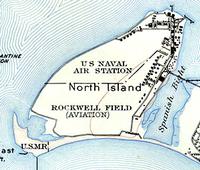
1930 map large view
|
|
Camp Kearny was established July 18, 1917, named in honor of Gen. Stephen Kearny who led the Army of the West to San Diego in 1846. It was one of 32 new camps created in May 1917, each designed to house 40,000 troops with 1200 buildings on 10,000 acres. Camp Kearny was located 11.5 miles north of San Diego on 12,721 acres and gave its name to the surrounding mesa. It cost $4.5 million to build and ended Oct. 31, 1920. (see pictures)
|
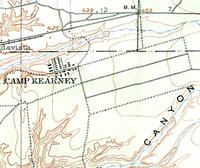
1930 map large view
|
|
The Marine Corps base on the bay tidelands called Dutch Flats was authorized by a Naval appropriation bill of August 29, 1916, in large part due to the efforts of Congressman William Kettner. The Marine Barracks in Balboa Park had been established Dec. 19, 1914, by Col. Joseph Pendleton while the status of a permanent base was debated in the federal government. The Marine 4th Regiment had been sent to San Diego in 1910 due to the Mexican Revolution and were stationed on North Island. When the Panama-Pacific Exposition opened in 1914, Col. Pendleton set up a model Marine camp on the fairgrounds in Balboa Park and it became the Marine Barracks. The Navy General Board approved a base Jan. 8, 1916 and the tideland area was dredged and filled until groundbreaking could begin in 1919 for permanent buildings. The Marines moved from Balboa Park to the new Dutch Flats installation after it was commissioned Marine Barracks Dec. 1, 1921. (see pictures)
|
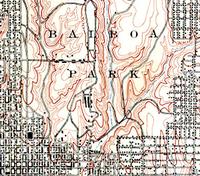
1930 map large view
|
|
The U. S. Naval Training Station (NTS) was proposed in 1916 by William Kettner of the Eleventh Congressional District in California and member of the San Diego Chamber of Commerce. He gained the support of Franklin D. Roosevelt, Assistant Secretary of Navy when he visited San Diego in 1914 and 1915, and a temporary base was established in Balboa Park during 1917. During World War I, the Navy established a War Dispensary in the Park with tents to care for the sick, and this became the Naval Hospital in 1919. The City of San Diego granted 142 acres of tideland and the Chamber of Commerce granted 135 acres to create a Naval Training Center on San Diego Bay in 1919. Construction began in 1921 and the U.S. Naval Training Station, San Diego, was officially commissioned June 1, 1923. (see pictures)
|
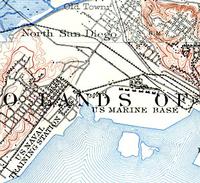
1930 map large view
|
|
Other early Navy installations expanded during World War I. The oldest Navy shore establishment in San Diego was the coaling station on Point Loma since 1901, officially known after 1904 as the La Playa Coaling Station. The Navy built a radio station on Point Loma in 1906, and added a transmitting station at Chollas Heights in 1916 with 600-foot radio antenna towers.
|
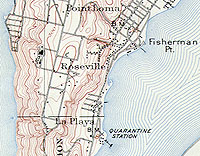
1930 map large view
|
Sources: |
|
| 1930 map from San Diego Historical Society - N or S large views
Coletta, Paolo E. United States Navy and Marine Corps Bases, Domestic. New York, Greenwood, 1985.
Hinds, James W. "San Diego's Military Sites," typed mss, San Diego Historical Society, 1986)
Naval Air Stations
|
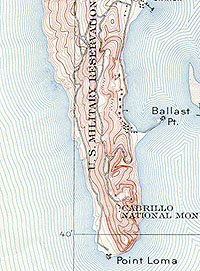
1930 map large view
|
|
| revised 2/13/99 by Schoenherr |











